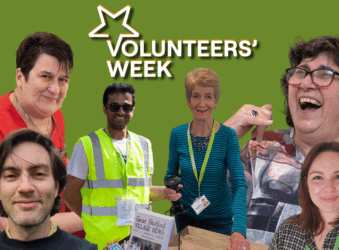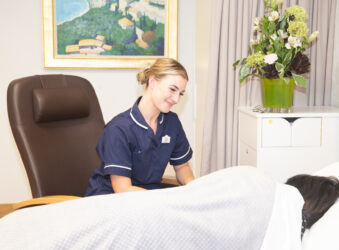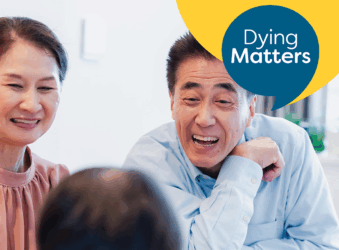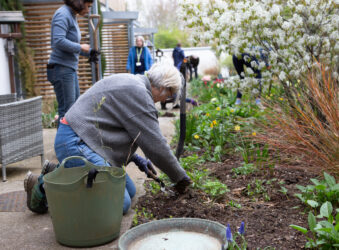An Unexpected Chapter for our Director of Fundraising and Communications
Share this article
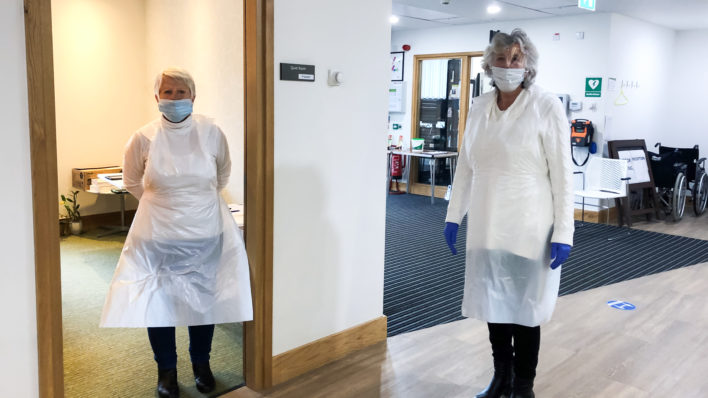
In order to cope with the demands of the pandemic, members of the Supportive Services side of our team have been redeployed (some full time, others part time) to help support our colleagues and requirements in our Clinical Services.
One example of this, is that a number of our Management Team have been recruited into a team of colleagues and volunteers providing lateral flow tests for visitors to the Hospice, seven days a week.
Director of Fundraising and Communications, Donna Talbot reflects on the changes the pandemic has had for her team and the fresh appreciation she has for our amazing clinical colleagues, after taking on a brand new role – quite different from what she is used to.
An Unexpected Chapter for our Director of Fundraising & Communications – redeployment
A big adjustment
In more usual times you’ll find me at fundraising activities and events, attending cheque presentations or maybe hear me on the radio sharing updates from the Charity.
So much has changed in the last year. I recall a lunch, organised by our President Lady Chadwyck Healey, being the first event where hand-gel was passed around the table whilst we chatted. We all talked about the terrible virus which was wreaking havoc around the world. Shortly after I stood on the start line of a half marathon saying to fellow runners, commenting, perhaps in disbelief, that this may be the last one of these for a while. What an understatement that proved to be!
Since then, everything has been turned upside down for us all at home and work.
Making new plans
Last March, we reviewed all fundraising activities that due to take place between March and November. At that time we were confident that by November the worst would have passed and we would soon be returning to normality, if this hadn’t already happened.
As each event in the calendar approached, we found ourselves reinventing and finding ways to make the impossible, possible.
We found new ways to fundraise. We reached out and asked for the support of our donors and they responded with incredible generosity. We even found that many new people came forward to show their support for the first time. All of this showed the absolute faith in and commitment of our community to Arthur Rank Hospice Charity and everything it stands for. Making a real difference
The Fundraising and Communications Team have always been in awe of the compassionate care and support provided to patients and their families by our clinical colleagues and never more so than during this pandemic.
Alongside donations came wonderful notes, with website dedications came heartfelt expressions of thanks, and accompanying fundraising pages were amazing stories as individuals chose to support the Charity in their own way. All special reminders of the amazing work our team undertake every day at the Hospice, at the Alan Hudson Day Treatment Centre and in the homes of people across Cambridgeshire.
Redeployment of colleagues
Throughout the year we explored how fundraising and communications colleagues could help support those clinical areas most under pressure by moving into temporary roles.
Although our team are not clinically trained, our skills could be a great help with jobs like manning the phones, providing cover for reception areas, collecting PPE and assisting in roles where our volunteers have had to stand down due to shielding or other reasons. The whole team were also willing to be trained in anything that would help our clinical colleagues focus on the jobs that only they could do.
Supervising lateral flow tests for visitors
During this third lockdown an opportunity arose for me to help supervise the patient visitor testing team.
This is a team of two volunteers responsible for administering the lateral flow tests for people visiting our Inpatient unit. Although the daily team is small, setting it up needed significant planning and support from other colleagues in the organisation. Hannah who manages our Voluntary Services team set about compiling a list of willing volunteers, our CEO reached out to senior colleagues and very rapidly a rota, of up to five people per day covering seven days a week, was created.
As one of those who had volunteered to be part of the new team, my first step was to complete specific training around the process, the donning and removal of PPE and of course communicating the result of the tests. Like so much of what we do now, this was of course online and included an assessment.
Completing the training
With this knowledge absorbed, I began to feel prepared for the next step: shadowing a colleague in this role. My aim at this point was to fully understand the process and ask my (long!) list of questions. I was allocated to shadow Kristie our Transitioning Young Adults Co-ordinator. She has a wealth of clinical experience, so it was a terrific opportunity for me to, not only to learn what was expected of me, but to also learn more about Kristie and where all her training stemmed from.
Like everyone at the Charity, Kristie gave me the time that I needed and was kind and responsive to my questions. At no point did I feel any of my questions were silly (however detailed!) and I immediately had faith in her answers, as is the #TeamArthur way.
My first shift
On my arrival for my shift, Sheila, a volunteer I know well, was already waiting for me. Sheila is always so prompt and over the years has turned her hand to so many of the roles at the Charity, that it was no surprise that her warm smile greeted me from behind a face mask!
We had just five people booked in at the start of the day but I was keen to be ready for the first person’s arrival. We set about getting everything ready: ensuring everything was sanitised; making the PPE easily available; checking we all knew the drill and were comfortable to ask questions or provide reminders to each other about next steps as we all undertook the process for the first time.
The first step for visitors is to fill out information which are a combination of paper and online forms. They were all so wonderfully understanding about everything we had to do. As anyone who has had one will know, the test is uncomfortable, but was duly completed by each person, who then patiently waited in their vehicle in our on-site car park for their result. The list of people grew as the day progressed and as my first volunteer Sheila went off shift, she was replaced by Ian and Pauline. Ian had already been in once during the week and was able to show Pauline the necessary steps.
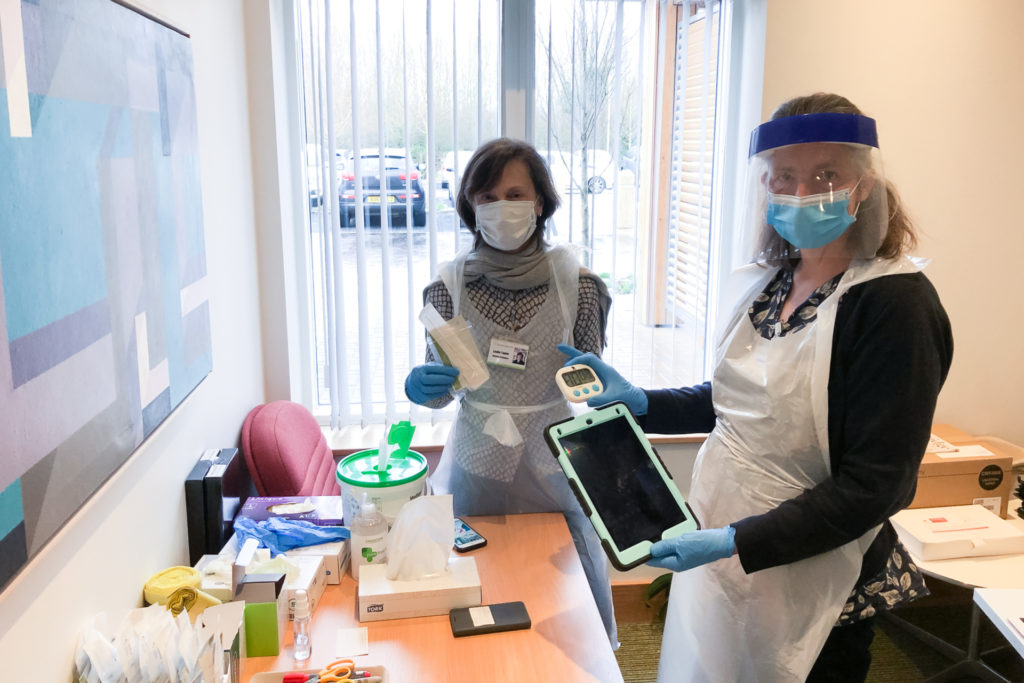
The practicalities of PPE and working in this environment
My respect for colleagues working in clinical roles was further heightened with each and every change of PPE between individual’s tests. Everyday needs like stopping for a drink or going to the bathroom all require more planning and take longer than you may expect, due to the unpeeling of the layers of protection. Suddenly the simplest things are more complicated and your movement really is quite restricted.
However, despite all of that, I was so grateful to be surrounded by real people, having worked at home alone for much of the pandemic. Our volunteers bring such positivity to all that they do and as a fundraiser I thrive on the company of others. Being together, doing an activity to help ensure the safety of our patients and their families felt like a great privilege for me and the volunteers.
The overwhelming importance of family
My greatest reflection from the day is the importance of family. We conducted 15 tests during the session. I met people of all ages; father and sons, father and daughters, husband and wives, and the list goes on. In every instance, people cared about each other, helped one another with parts of the process, and provided support as they waited nervously for the result. When someone was on their own, the volunteers and I took time to make sure they felt well supported and received all the help they needed. The relief felt when the test was negative was so evident.
The significance of this result is far more than important than simply knowing that at this moment they are COVID free – it means they can visit their loved one, safe in the knowledge that they are not putting them at risk.
Visiting a Hospice can be very difficult even in normal times and in periods of great uncertainty, families need this time together, even more.
Memories don’t end because we are living through a pandemic and my colleagues, our volunteers, our patients and their families are working hard to maintain as much normality as possible. Providing these tests is an important step towards doing all that we can to make every moment count in every day.
Read ‘An Unexpected Chapter – Inpatient Unit’
Read ‘An Unexpected Chapter – Day Therapy’
Read ‘An Unexpected Chapter – The Patient and Family Support Team’
Related articles
-

Hospice Volunteers recognised during National Volunteers Week 2025
Arthur Rank Hospice Charity says thank you to over 600 volunteers
-

Hospice delighted with the results of Quality Assurance Visit
Quality assurance visit was conducted as part of the Cambridgeshire and Peterborough Integrated Care Board (CPICB)
-

The Culture of Dying Matters for patients at Arthur Rank Hospice Charity
Read how the Charity supports patients individual needs
-

Hospice Volunteer Gardeners makeover the Inpatient Unit gardens
Volunteer gardeners support Hospice patients and their loved ones

